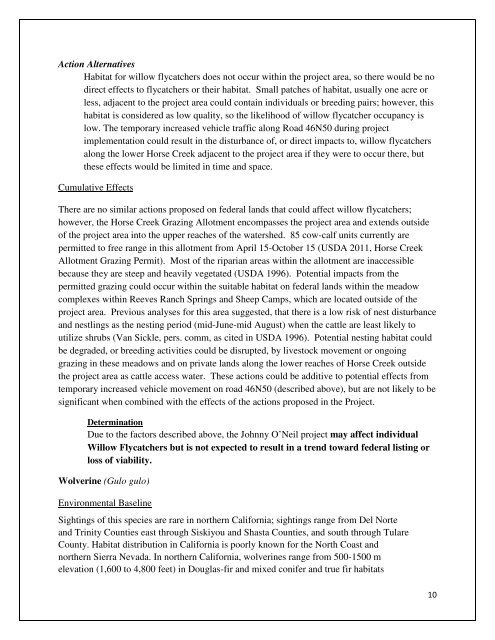Johnny O'Neil Late Successional Reserve Habitat Restoration and ...
Johnny O'Neil Late Successional Reserve Habitat Restoration and ...
Johnny O'Neil Late Successional Reserve Habitat Restoration and ...
Create successful ePaper yourself
Turn your PDF publications into a flip-book with our unique Google optimized e-Paper software.
Action Alternatives<br />
<strong>Habitat</strong> for willow flycatchers does not occur within the project area, so there would be no<br />
direct effects to flycatchers or their habitat. Small patches of habitat, usually one acre or<br />
less, adjacent to the project area could contain individuals or breeding pairs; however, this<br />
habitat is considered as low quality, so the likelihood of willow flycatcher occupancy is<br />
low. The temporary increased vehicle traffic along Road 46N50 during project<br />
implementation could result in the disturbance of, or direct impacts to, willow flycatchers<br />
along the lower Horse Creek adjacent to the project area if they were to occur there, but<br />
these effects would be limited in time <strong>and</strong> space.<br />
Cumulative Effects<br />
There are no similar actions proposed on federal l<strong>and</strong>s that could affect willow flycatchers;<br />
however, the Horse Creek Grazing Allotment encompasses the project area <strong>and</strong> extends outside<br />
of the project area into the upper reaches of the watershed. 85 cow-calf units currently are<br />
permitted to free range in this allotment from April 15-October 15 (USDA 2011, Horse Creek<br />
Allotment Grazing Permit). Most of the riparian areas within the allotment are inaccessible<br />
because they are steep <strong>and</strong> heavily vegetated (USDA 1996). Potential impacts from the<br />
permitted grazing could occur within the suitable habitat on federal l<strong>and</strong>s within the meadow<br />
complexes within Reeves Ranch Springs <strong>and</strong> Sheep Camps, which are located outside of the<br />
project area. Previous analyses for this area suggested, that there is a low risk of nest disturbance<br />
<strong>and</strong> nestlings as the nesting period (mid-June-mid August) when the cattle are least likely to<br />
utilize shrubs (Van Sickle, pers. comm, as cited in USDA 1996). Potential nesting habitat could<br />
be degraded, or breeding activities could be disrupted, by livestock movement or ongoing<br />
grazing in these meadows <strong>and</strong> on private l<strong>and</strong>s along the lower reaches of Horse Creek outside<br />
the project area as cattle access water. These actions could be additive to potential effects from<br />
temporary increased vehicle movement on road 46N50 (described above), but are not likely to be<br />
significant when combined with the effects of the actions proposed in the Project.<br />
Determination<br />
Due to the factors described above, the <strong>Johnny</strong> O’Neil project may affect individual<br />
Willow Flycatchers but is not expected to result in a trend toward federal listing or<br />
loss of viability.<br />
Wolverine (Gulo gulo)<br />
Environmental Baseline<br />
Sightings of this species are rare in northern California; sightings range from Del Norte<br />
<strong>and</strong> Trinity Counties east through Siskiyou <strong>and</strong> Shasta Counties, <strong>and</strong> south through Tulare<br />
County. <strong>Habitat</strong> distribution in California is poorly known for the North Coast <strong>and</strong><br />
northern Sierra Nevada. In northern California, wolverines range from 500-1500 m<br />
elevation (1,600 to 4,800 feet) in Douglas-fir <strong>and</strong> mixed conifer <strong>and</strong> true fir habitats<br />
10
















